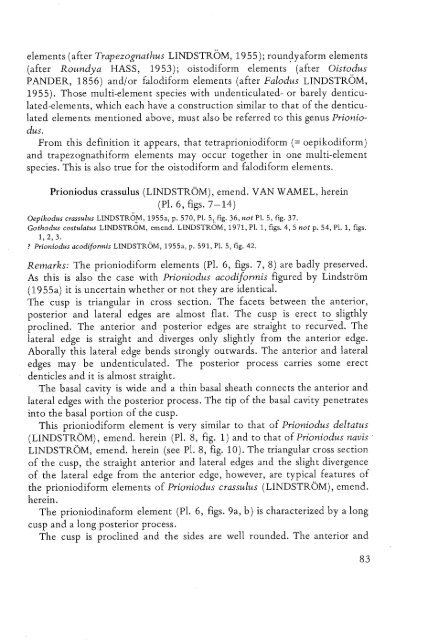UTRECHT MICROPALEONTOLOGICAL BUllETINS
UTRECHT MICROPALEONTOLOGICAL BUllETINS
UTRECHT MICROPALEONTOLOGICAL BUllETINS
You also want an ePaper? Increase the reach of your titles
YUMPU automatically turns print PDFs into web optimized ePapers that Google loves.
elements (after Trapezognathus LINDSTROM, 1955); roun~yaform elements<br />
(after Roundya HASS, 1953); oistodiform elements (after Oistodus<br />
PANDER, 1856) and/or falodiform elements (after Falodus LINDSTROM,<br />
1955). Those multi-element species with undenticulated- or barely denticulated-elements,<br />
which each have a construction similar to that of the denticulated<br />
elements mentioned above, must also be referred to this genus Prioniodus.<br />
From this definition it appears, that tetraprioniodiform (= oepikodiform)<br />
and trapezognathiform elements may occur together in one multi-element<br />
species. This is also true for the oistodiform and falodiform elements.<br />
Prioniodus crassulus (LINDSTROM), emend. VAN WAMEL, herein<br />
(PI. 6, figs. 7-14)<br />
Oepikodus crassulus LINDSTROM, 1955a, p. 570, PI. 5, fig. 36, not PI. 5, fig. 37.<br />
Gothodus costulatus LINDSTROM, emend. LINDSTROM, 1971, PI. 1, figs. 4, 5 not p. 54, PI. 1, figs.<br />
1,2,3.<br />
? Prioniodus acodiformis LINDSTROM, 1955a, p. 591, PI. 5, fig. 42.<br />
Remarks: The prioniodiform elements (PI. 6, figs. 7, 8) are badly preserved.<br />
As this is also the case with Prioniodus acodiformis figured by Lindstrom<br />
(1955a) it is uncertain whether or not they are identical.<br />
The cusp is triangular in cross section. The facets between the anterior,<br />
posterior and lateral edges are almost flat. The cusp is erect to sligthly<br />
proclined. The anterior and posterior edges are straight to recurved. The<br />
lateral edge is straight and diverges only slightly from the anterior edge.<br />
Aborally this lateral edge bends strongly outwards. The anterior and lateral<br />
edges may be undenticulated. The posterior process carries some erect<br />
denticles and it is almost straight.<br />
The basal cavity is wide and a thin basal sheath connects the anterior and<br />
lateral edges with the posterior process. The tip of the basal cavity penetrates<br />
into the basal portion of the cusp.<br />
This prioniodiform element is very similar to that of Prioniodus deltatus<br />
(LINDSTROM), emend. herein (PI. 8, fig. 1) and to that of Prioniodus navis<br />
LINDSTROM, emend. herein (see PI. 8, fig. 10). The triangular cross section<br />
of the cusp, the straight anterior and lateral edges and the slight divergence<br />
of the lateral edge from the anterior edge, however, are typical features of<br />
the prioniodiform elements of Prioniodus crassulus (LINDSTROM), emend.<br />
herein.<br />
The prioniodinaform element (PI. 6, figs. 9a, b) is characterized by a long<br />
cusp and a long posterior process.<br />
The cusp is proclined and the sides are well rounded. The anterior and
















